A Study of the Oklahoma City Urban Heat Island Effect Using a WRF/Single-Layer Urban Canopy Model, a Joint Urban 2003 Field Campaign, and MODIS Satellite Observations
Abstract
:1. Introduction
2. Joint Urban 2003 Field Campaign
3. Other Data and Methods
3.1. Satellite Observation
3.2. WRF/Single-Layer Urban Canopy Model (SLUCM) Simulation
4. Results
4.1. Satellite Observation
4.2. Ground Observations
4.3. WRF/Single-Layer Urban Canopy Model (SLUCM) Simulation Analysis
5. Conclusions
- An urban area is a highly heterogeneous environment and different cities have different types of surrounding land covers, geometric conditions, and population densities. As a result, the UHI differs between cities such as OKC and Xi’an, although both are inland cities at the same latitude. Satellite retrieval captured the UHI for both cities. Xi’an had the stronger UHI than OKC, which suggests that the population density, building density, and city size are important factors in determining the UHI intensity.
- There are competing factors and physical processes in an urban surface-layer that make a UHI or UCI both possible. Specifically, building materials had a high heat capacity, which slowed down the warming at the surface during daytime and warmed the surface at nighttime. Furthermore, the building shadows reduced surface temperatures, as shown in ground observations, where a significant UCI occurred on summer days at noon in OKC. Nevertheless, less soil moisture and less vegetation cover over urban regions lead to a surface warming since all absorbed solar radiation was used to heat up the surface.
- Skin temperature and 2 m air temperature fields may have different UHI or UCI signals. The satellite observed skin temperature in OKC, which showed an evident UHI, was monthly averaged. The ground observation of 2 m air temperature and modeled surface skin and air temperatures, which suggested a UCI, were only during daytime and at hourly resolution.
- The coupled WRF/Noah/SLUCM modeling system can re-produce the signal of the UHI or UCI, although its intensity and duration remain problematic. Nevertheless, a main issue affecting WRF urban simulation is that the default settings in the USGS 24-category land use categories are outdated for many cities. For instance, the simulated urban fraction for OKC is only about 2%, while its actual value is about 20%, based on MODIS.
- The coupled WRF/Noah/SLCUM model reproduces the UCI during summer daytime in OKC, which was consistent with the ground observations. However, it failed to accurately capture the influences of cities on prevalent atmospheric motions, such as wind speed, wind direction, and energy flux.
Acknowledgments
Author Contributions
Conflicts of Interest
References
- Trenberth, K.T.; Fasullo, J.T.; Kiehl, J. Earth’s global energy budget. Bull. Am. Meteorol. Soc. 2009, 90, 311–323. [Google Scholar] [CrossRef]
- Jin, M.; Dickinson, R.E. Land surface skin temperature climatology: Benefitting from the strengths of satellite observations. Environ. Res. Lett. 2010, 5, 044004. [Google Scholar] [CrossRef]
- Jin, M.; Dickinson, R.E.; Vogelmann, A.M. A Comparison of CCM2/BATS Skin Temperature and Surface-Air Temperature with Satellite and Surface Observations. J. Clim. 1997, 10, 1505–1524. [Google Scholar] [CrossRef]
- Jin, M.; Mullens, T. Land-biosphere-atmosphere interactions over Tibetan Plateau from MODIS observations. Environ. Res. Lett. 2012, 7, 014003. [Google Scholar] [CrossRef]
- Landsberg, H.E. The Urban Climate; Academic Press: New York, NY, USA, 1981; 275p. [Google Scholar]
- Oke, T.R. The energetic basis of the Urban Heat Island. Q. J. R. Meteorol. Soc. 1982, 108, 1–24. [Google Scholar] [CrossRef]
- Oke, T.R. Canyon geometry and the nocturnal Urban Heat Island. Int. J. Climatol. 1981, 10, 237–245. [Google Scholar] [CrossRef]
- Jin, M.; Dickinson, R.E.; Zhang, D. The footprint of urban areas on global climate as characterized by MODIS. J. Clim. 2005, 18, 1551–1565. [Google Scholar] [CrossRef]
- Basara, J.B.; Basara, H.G.; Illston, B.G.; Crawford, K.C. The Impact of the Urban Heat Island during an Intense Heat Wave in Oklahoma City. Adv. Meteorol. 2010, 2010. [Google Scholar] [CrossRef]
- Jin, M.; Kessomkiat, W.; Pereira, G. Satellite-observed urbanization characters in Shanghai, China: Aerosols, urban heat island effect, and land-atmosphere interactions. Remote Sens. 2011, 3, 83–99. [Google Scholar] [CrossRef]
- Johansson, E.; Spangenberg, J.; Gouvêa, M.L.; Freitas, E.D. Scale-integrated atmospheric simulations to assess thermal comfort in different urban tissues in the warm humid summer of São Paulo, Brazil. Urban Clim. 2013, 6, 24–43. [Google Scholar] [CrossRef]
- Arnfield, A.J. Two decades of urban climate research: A review of turbulence, exchanges of energy and water, and the urban heat island. Int. J. Clim. 2003, 23, 1–26. [Google Scholar] [CrossRef]
- Chin, H.-N.S.; Leach, M.J.; Sugiyama, G.A.; Leone, J.M.; Walker, H.; Nasstrom, J.S.; Brown, M.J. Evaluation of an urban canopy parameterization in a mesoscale model using VTMX and URBAN 2000 data. Mon. Weather Rev. 2005, 133, 2043–2068. [Google Scholar] [CrossRef]
- Coutts, A.M.; Beringer, J.; Tapper, N.J. Impact of increasing urban density on local climate: Spatial and temporal variation in the surface energy balance in Melbourne, Australia. J. Appl. Meteorol. Climatol. 2007, 46, 477–493. [Google Scholar] [CrossRef]
- Jones, P.D.; Kelly, P.M.; Goodess, C.M. The effect of urban warming on the northern hemisphere temperature average. J. Clim. 1989, 2, 285–290. [Google Scholar] [CrossRef]
- Kim, Y.-H.; Baik, J.-J. Spatial and temporal structure of the urban heat island in Seoul. J. Appl. Meteorol. 2005, 44, 591–605. [Google Scholar] [CrossRef]
- Martilli, A. Numerical study of urban impact on boundary layer structure: Sensitivity to wind speed, urban morphology, and rural soil moisture. J. Appl. Meteorol. 2002, 41, 1247–1266. [Google Scholar] [CrossRef]
- Masson, V. A physically-based scheme for the urban energy budget in atmospheric models. Bound. Layer Meteorol. 2000, 94, 357–397. [Google Scholar] [CrossRef]
- Miao, S.; Chen, F.; LeMone, M.A.; Tewari, M.; Li, Q.; Wang, Y. An observational and modeling study of characteristics of urban heat island and boundary layer structures in Beijing. J. Appl. Meteorol. Climatol. 2009, 48, 484–501. [Google Scholar] [CrossRef]
- Johnson, G.T.; Steyn, D.G.; Watson, I.D. Simulation of surface Urban Heat Island. Bound. Layer Meteorol. 1991, 56, 339–358. [Google Scholar]
- Zeuner, G.; Jauregui, E. The surface energy balance in Mexico City. Atmos. Environ. 1992, 26, 433–444. [Google Scholar]
- Ren, G.; Zhou, Y.; Chu, Z.; Zhou, J.; Zhang, A.; Guo, J.; Liu, X. Urbanization effects on observed surface air temperature trends in north China. J. Clim. 2008, 21, 1333–1348. [Google Scholar] [CrossRef]
- Tewari, M.; Chen, F. A study of the urban boundary layer using different urban parameterizations and high-resolution urban panopy parameters with WRF. J. Appl. Meteorol. Climatol. 2011, 50, 1107–1128. [Google Scholar]
- Trusilova, K.; Jung, M.; Churkina, G. On climate impacts of a potential expansion of urban land in Europe. J. Appl. Meteorol. Climatol. 2009, 48, 1971–1980. [Google Scholar] [CrossRef]
- Montavez, J.P.; Rodriguez, A.; Jimenez, J.I. A study of the urban heat island of Granada. Int. J. Climatol. 2000, 20, 899–911. [Google Scholar] [CrossRef]
- Hamdi, R.; Van de Vyver, H. Estimating urban heat island effects on near-surface air temperature records of Uccle (Brussels, Belgium): An observational and modeling study. Adv. Sci. Res. 2011, 6, 27–34. [Google Scholar] [CrossRef]
- Yang, B. Simulation of urban climate with high-resolution WRF model: A case study in Nanjing, China. Asia Pac. J. Atmos. Sci. 2012, 48, 227–241. [Google Scholar] [CrossRef]
- Chen, F.; Kusaka, H.; Tewari, M.; Bao, J.-W.; Hirakuchi, H. Utilizing the Coupled WRF/LSM/Urban Modeling System with Detailed Urban Classification to Simulate the Urban Heat Island Phenomena over the Greater Houston Area. In Proceedings of the Fifth Symposium on the Urban Environment, Vancouver, BC, Canada, 22–27 August 2004. [Google Scholar]
- Salamanca, F.; Krpo, A.; Martilli, A.; Clappier, A. A new building energy model coupled with an urban canopy parameterization for urban climate simulations—Part I. Formulation, verification, and sensitivity analysis of the model. Theor. Appl. Climatol. 2010, 99, 331. [Google Scholar] [CrossRef]
- Garratt, J.R. The Atmospheric Boundary Layer; Cambridge University Press: Cambridge, UK, 1992; p. 315. [Google Scholar]
- Janković, V.; Hebbert, M. Hidden climate change–urban meteorology and the scales of real weather. Clim. Chang. 2012, 113, 23–33. [Google Scholar] [CrossRef]
- Jin, M.; Shepherd, J.M. Aerosol relationships to warm season clouds and rainfall at monthly scales over east China: Urban land versus ocean. J. Geophys. Res. 2008, 113, D24S90. [Google Scholar] [CrossRef]
- Allwine, K.J.; Flaherty, J.E. Joint Urban 2003: Study Overview and Instrument Locations; Pacific Northwest National Laboratory (PNNL): Richland, WA, USA, 2006; p. 15967.
- Kusaka, H.; Kondo, H.; Kikegawa, Y.; Kimura, F. A simple single-layer urban canopy model for atmospheric models: Comparison with multi-layer and slab models. Bound. Layer Meteorol. 2001, 101, 329–358. [Google Scholar] [CrossRef]
- Chen, F.; Kusaka, H.; Bornstein, R. The integrated WRF/urban modeling system: Development, evaluation, and applications to urban environmental problems. Int. J. Climatol. 2011, 31, 273–288. [Google Scholar] [CrossRef]
- King, M.D.; Menzel, W.P.; Kaufman, Y.J.; Tanre, D.; Gao, B.-C.; Platnick, S.; Ackerman, S.A.; Remer, L.A.; Pincus, R.; Hubanks, P.A. Cloud and aerosol properties, precipitable water, and profiles of temperature and humidity from MODIS. IEEE Trans. Geosci. Remote Sens. 2003, 41, 442–458. [Google Scholar] [CrossRef]

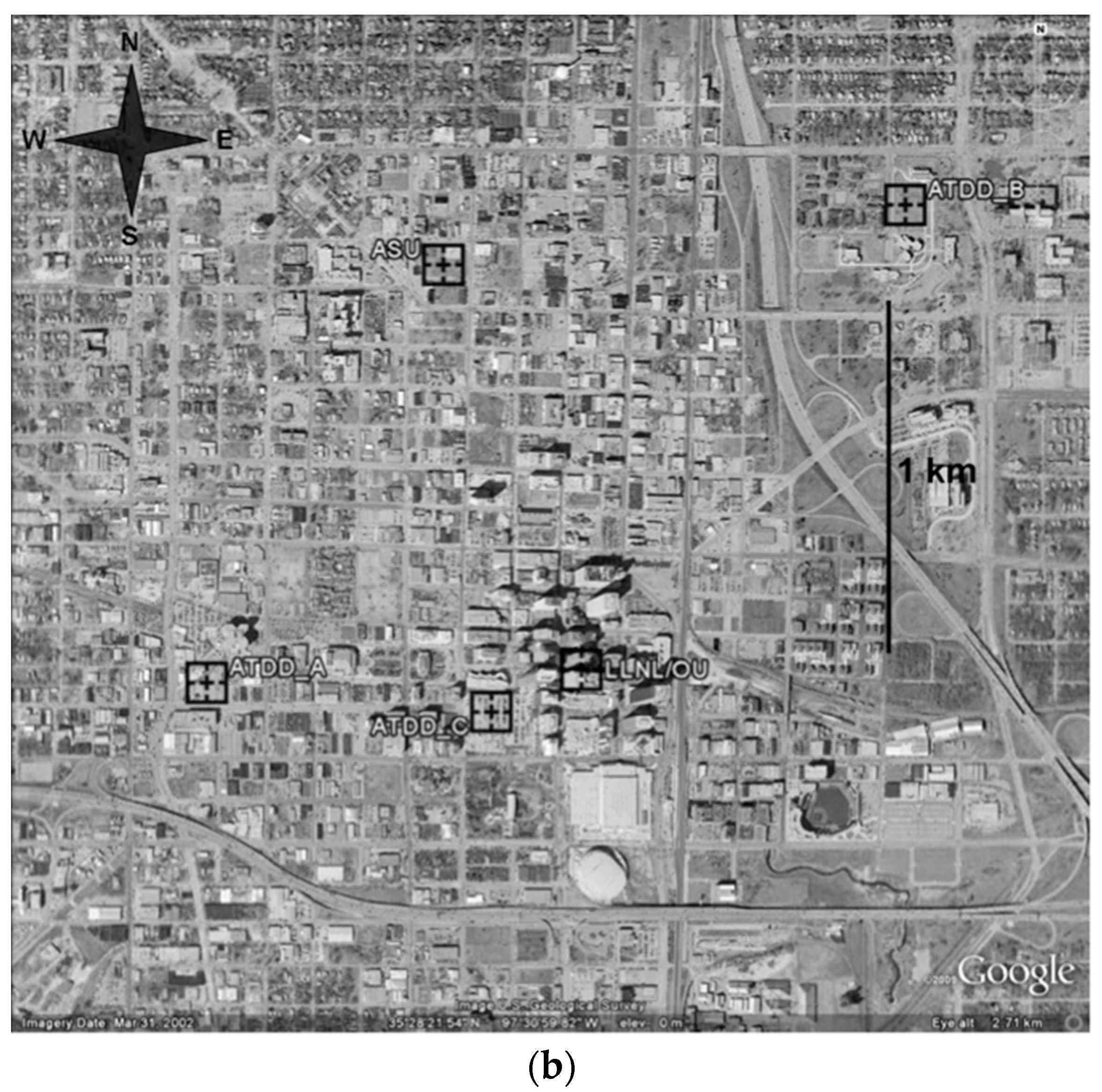

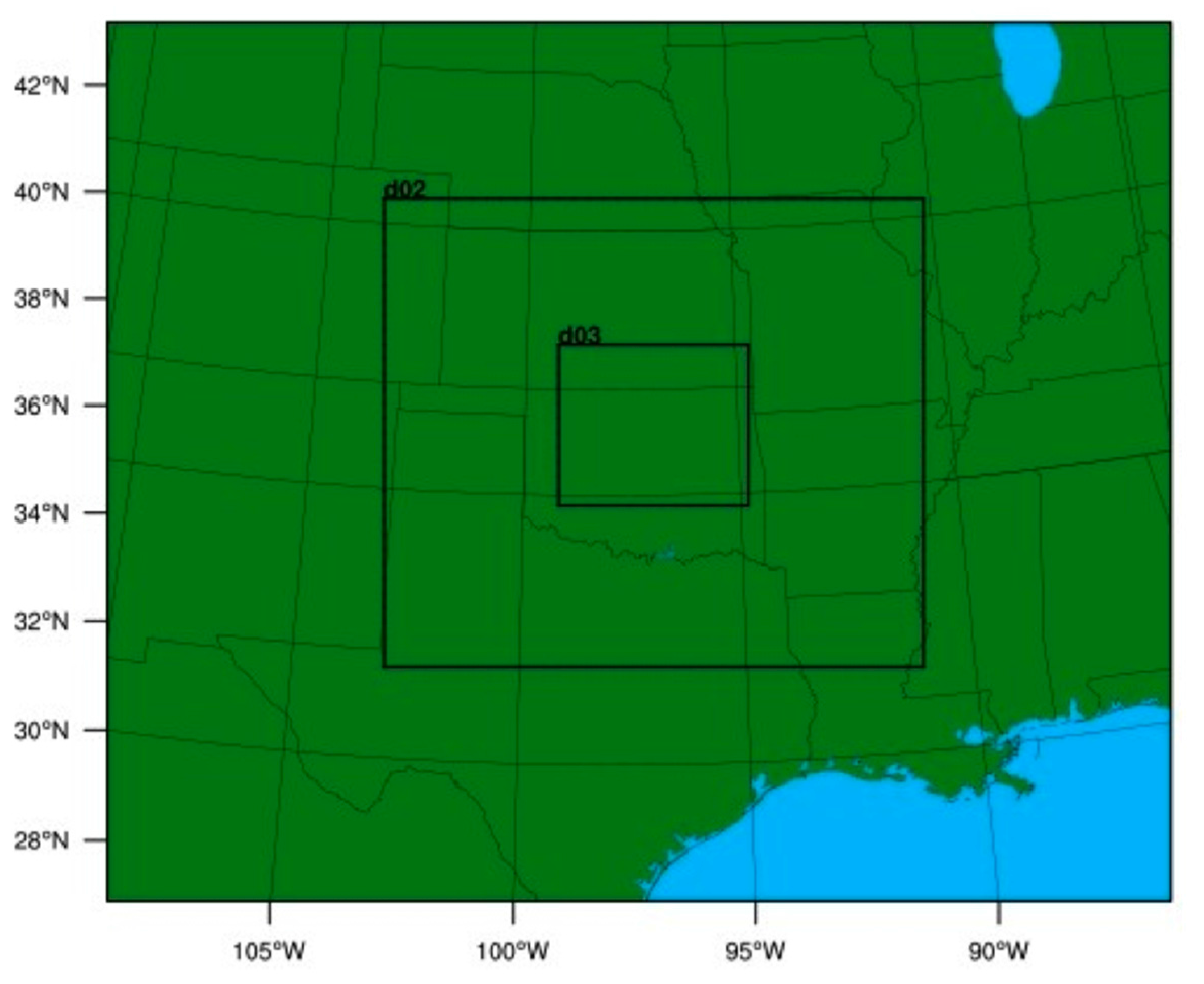

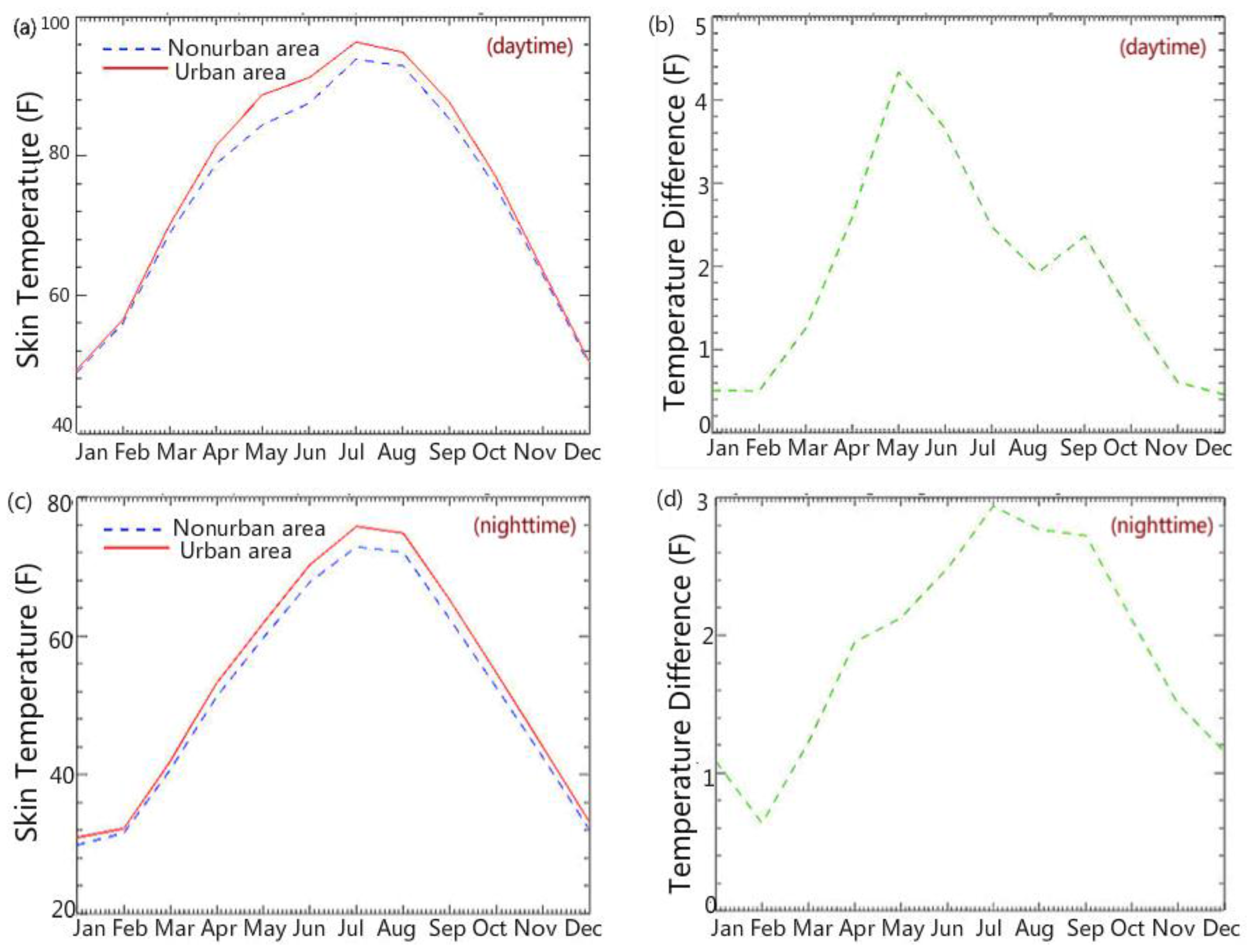
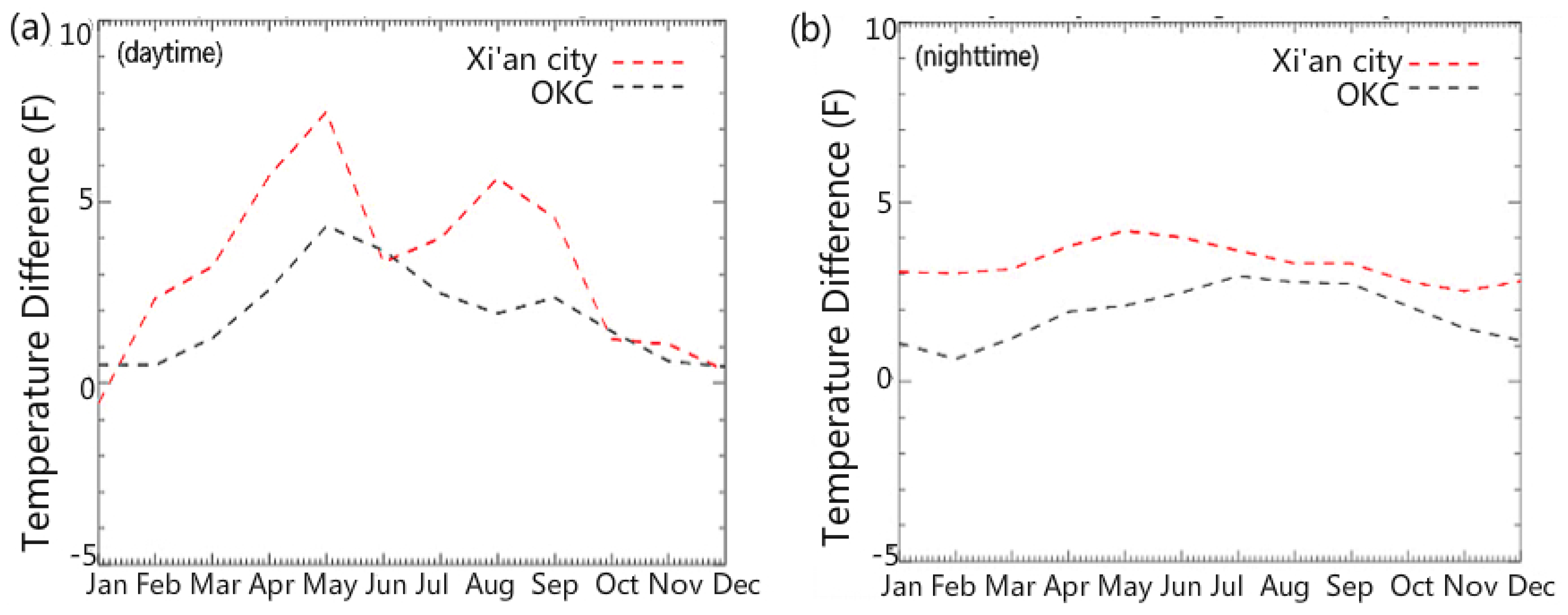
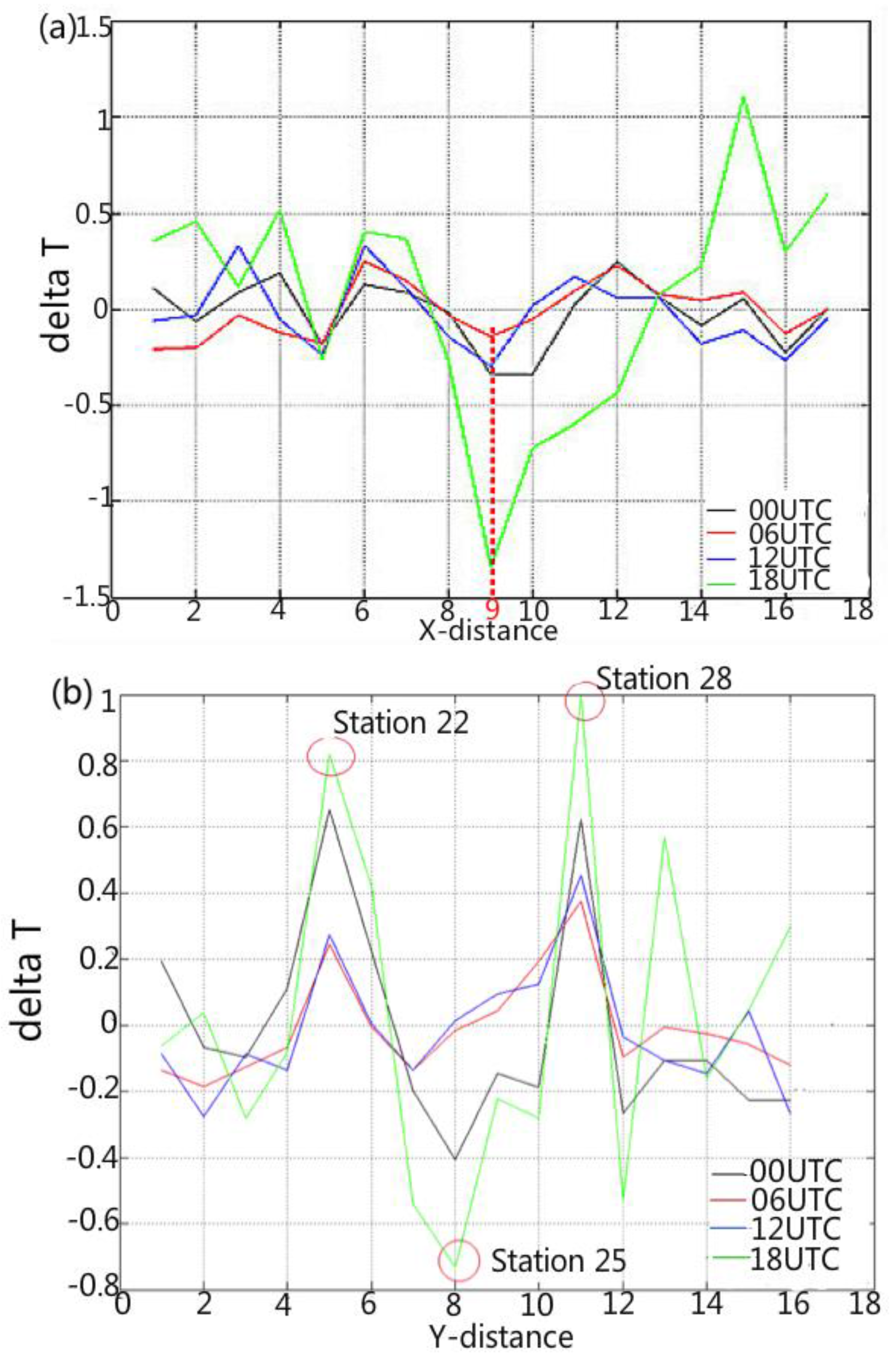
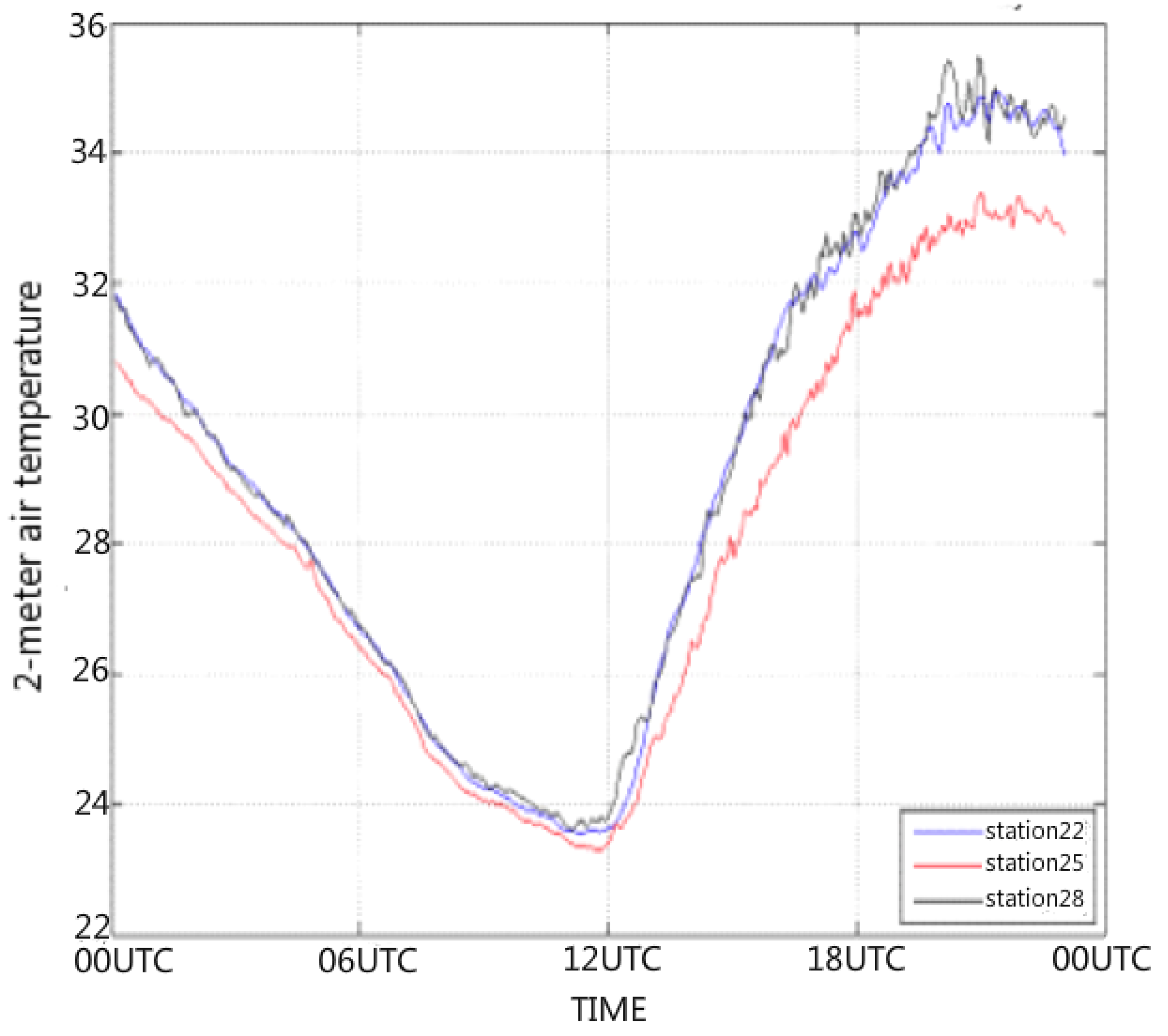
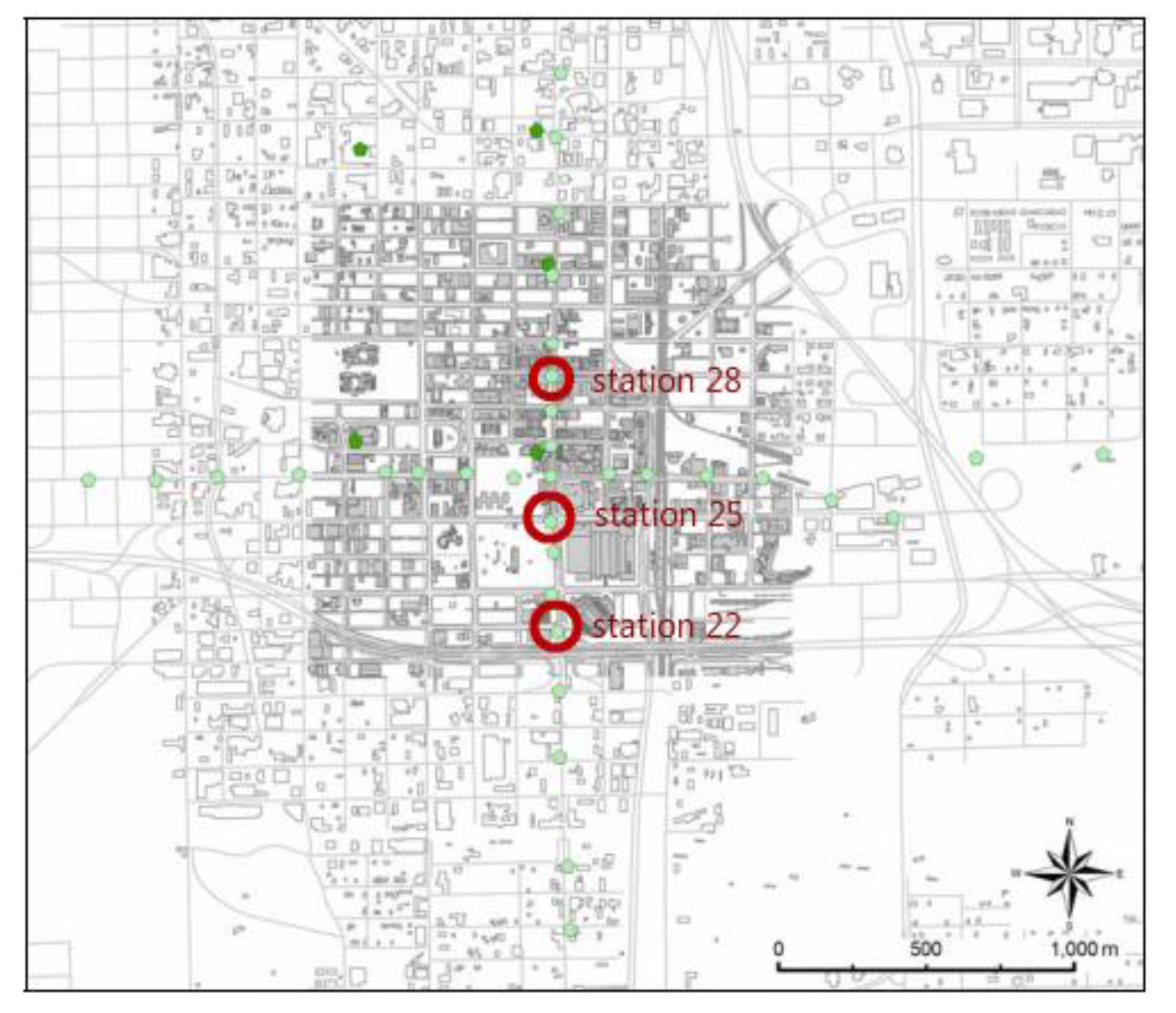
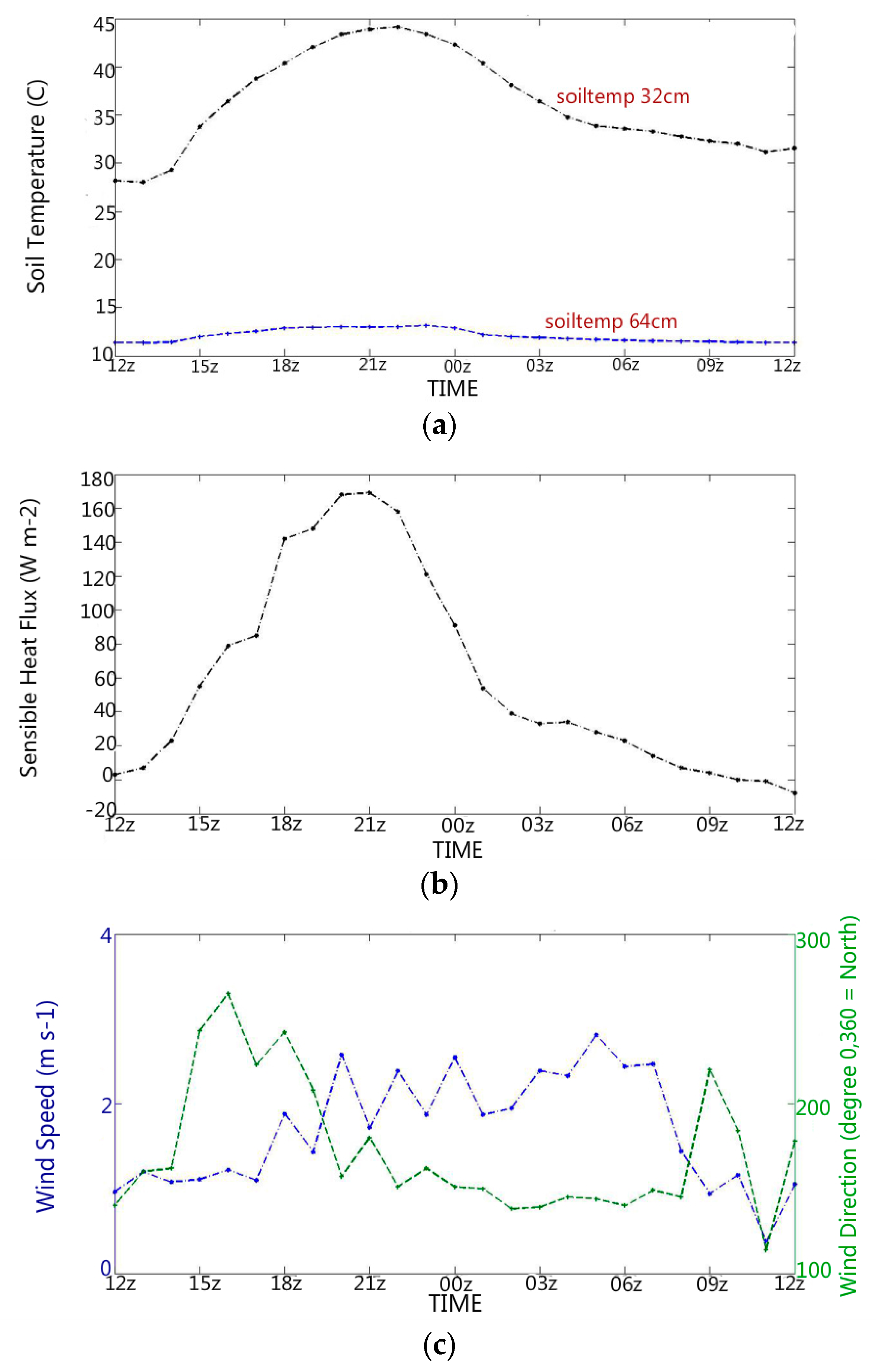

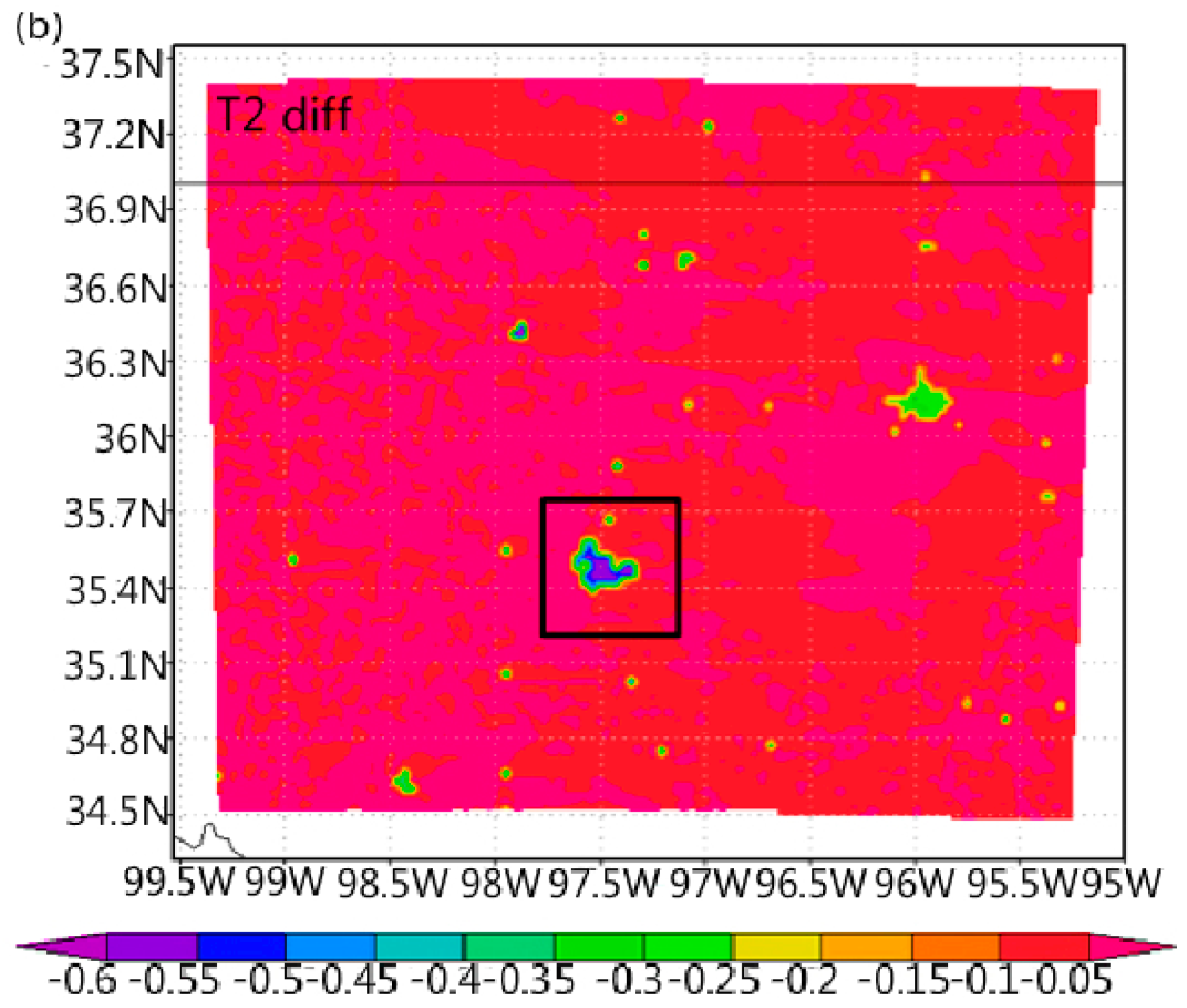
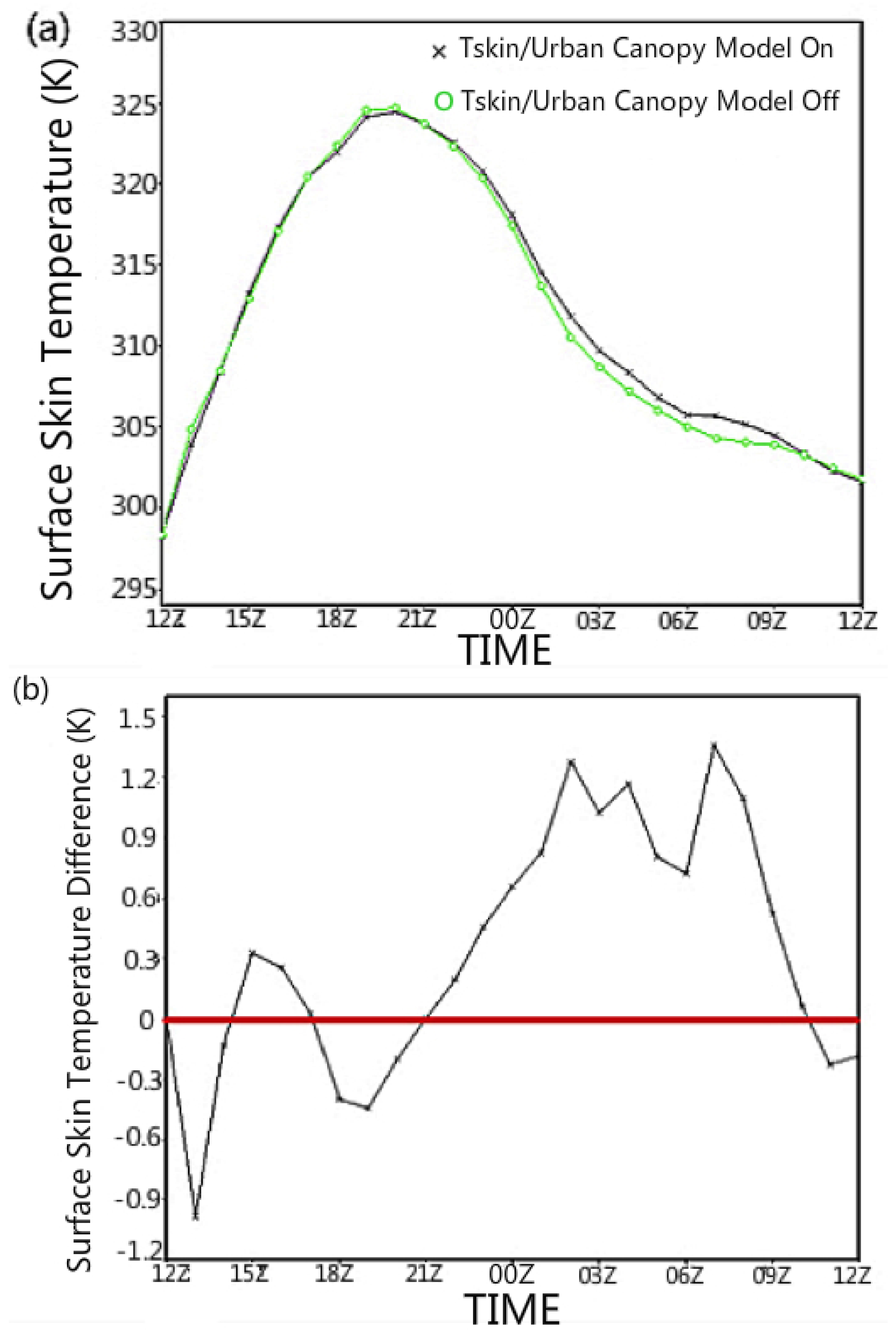
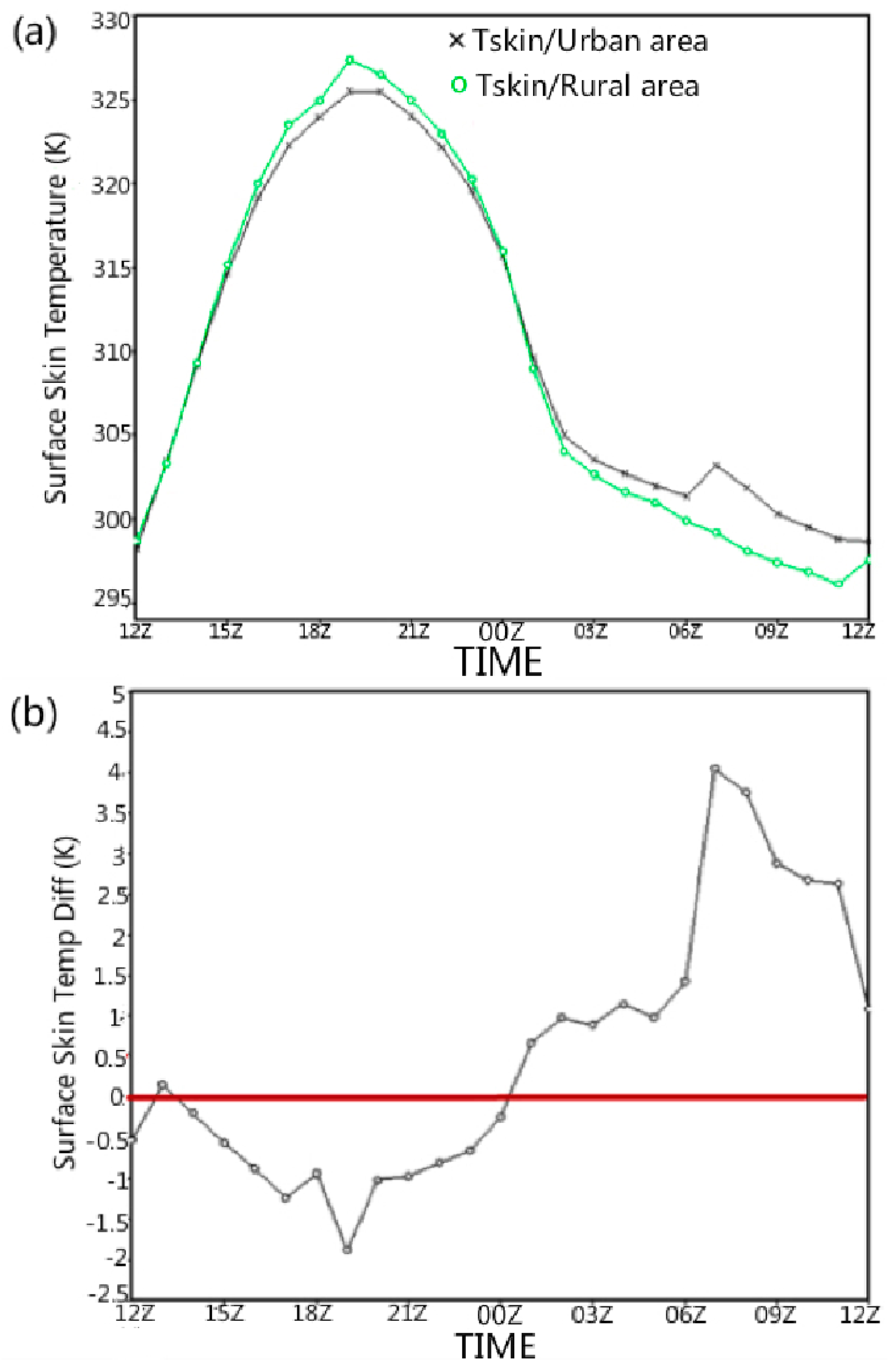
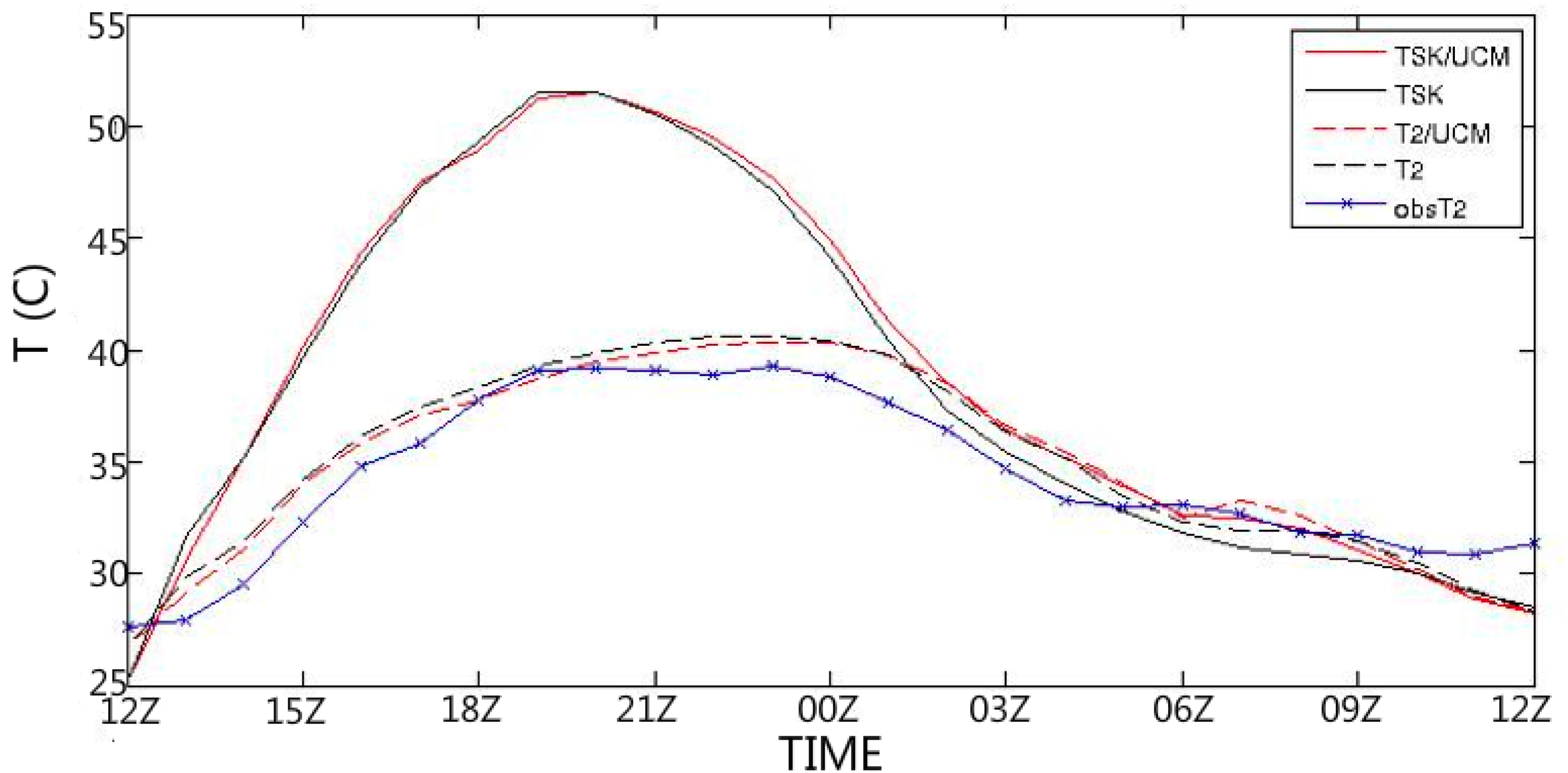

| Parameter | Symbol | Value | Unit |
| Roof level (building height) | zr | 15 | [m] |
| Normalized building height | h | 0.5 | |
| Normalized roof width | r | 0.25 | |
| Normalized road width | w | 0.75 | |
| Urban area ratio for a grid | Au | ||
| Vegetation area ratio for a grid | Av | 0 | |
| Roughness length for momentum above city | Z0m | 0.5 | [m] |
| Roughness length for momentum above canyon | Z0 | 0.667 | [m] |
| Roughness length above roof | zoR | 0.005 | [m] |
| Zero plane displacement height | d | 2.3 | [m] |
| Roof surface albedo | αR | 0.2 | |
| Wall surface albedo | αW | 0.2 | |
| Road surface albedo | αG | 0.2 | |
| Roof surface emissivity | ϵR | 0.97 | |
| Wall surface emissivity | ϵW | 0.97 | |
| Road surface emissivity | ϵG | 0.97 | |
| Canyon orientation | θcan | nπ/8 (n = 0 − 7) | [rad] |
| Physical Constant | Symbol | Value | Unit |
| Volumetric heat capacity of roof | ρRCR | 2.01 × 106 | [J m−3 K−1] |
| Volumetric heat capacity of wall | ρWCW | 2.01 × 106 | [J m−3 K−1] |
| Volumetric heat capacity of road | ρGCG | 2.01 × 106 | [J m−3 K−1] |
| Thermal conductivity of roof | λR | 2.28 | [W m−1 K−1] |
| Thermal conductivity of wall | λW | 2.28 | [W m−1 K−1] |
| Thermal conductivity of road | λG | 2.28 | [W m−1 K−1] |
© 2017 by the authors. Licensee MDPI, Basel, Switzerland. This article is an open access article distributed under the terms and conditions of the Creative Commons Attribution (CC BY) license (http://creativecommons.org/licenses/by/4.0/).
Share and Cite
Zhang, H.; Jin, M.S.; Leach, M. A Study of the Oklahoma City Urban Heat Island Effect Using a WRF/Single-Layer Urban Canopy Model, a Joint Urban 2003 Field Campaign, and MODIS Satellite Observations. Climate 2017, 5, 72. https://doi.org/10.3390/cli5030072
Zhang H, Jin MS, Leach M. A Study of the Oklahoma City Urban Heat Island Effect Using a WRF/Single-Layer Urban Canopy Model, a Joint Urban 2003 Field Campaign, and MODIS Satellite Observations. Climate. 2017; 5(3):72. https://doi.org/10.3390/cli5030072
Chicago/Turabian StyleZhang, Hengyue, Menglin S. Jin, and Martin Leach. 2017. "A Study of the Oklahoma City Urban Heat Island Effect Using a WRF/Single-Layer Urban Canopy Model, a Joint Urban 2003 Field Campaign, and MODIS Satellite Observations" Climate 5, no. 3: 72. https://doi.org/10.3390/cli5030072





